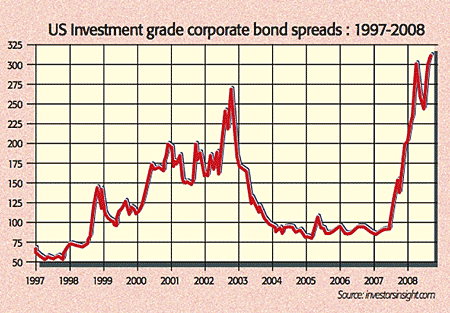
“Like a Hollywood monster… the credit crisis refuses to lie down and die,” says The Economist. Despite a series of interest-rate cuts, special liquidity schemes and bank bail-outs by the authorities, credit markets have come under mounting pressure. Spreads on all kinds of debt – from investment grade corporate and “lesser eurozone government” paper to interbank lending rates – are either at their widest since the crunch began, or on an upward trend, says Breakingviews’ Edward Hadas.
European gauges of the cost of insuring against corporate default for both investment grade and high-yield bonds have crept up again, with the former at a one-month high. Interbank rates remain elevated on both sides of the Atlantic as banks remain suspicious of each other and keep hoarding cash. In Britain, interbank lending slumped to £205bn in July, down from $635bn a year ago and below the average since the crunch began last August, says Bloomberg.com. In America, the spread over the expected central bank rate that banks charge each other for short-term cash is three times higher than in January and derivatives markets point to a further increase.
Spreads on the debt of some US banks are higher than that on Iraqi government debt and investment grade American firms are paying almost 3% more than US Treasuries, meaning that spreads are higher than in the last recession, says John Mauldin on Investorsinsight.com. Average junk bond spreads have jumped from 2.4% to over 8.6% in a year. The credit squeeze is an “ongoing nightmare”, says Stuart Thomson of Resolution, “and no-one is sure when we’re going to wake up”.
The latest jitters concern a further likely squeeze on bank lending as the financial sector will have trouble refinancing $800bn of debt borrowed in 2006 at far more expensive rates. The admission of the Federal Deposit Insurance Corporation (which has increased the number of banks on its “danger list” from 90 to 117), that it may need to tap the public purse as banks come under increasing pressure from bad debts, hasn’t helped either, says The Economist. To complicate matters further, many are exposed to the ailing mortgage giants Fannie Mae and Freddie Mac through holdings of preferred stock and credit default swaps (insurance written on Fannie and Freddie’s debt).
The wider problem here is the prospect of a “negative feedback loop” as losses at banks prompts them to restrict lending, making it harder for consumers and firms to repay their debts, which in turn presages a further contraction in lending. There are plenty more losses to come. Delinquencies on prime mortgages worth over $417,000 quadrupled to 4% of outstanding loans in May and US credit-card delinquencies have reached levels seen in the last recession. Commercial real estate and corporate losses have yet to kick in. Throw in the darkening global outlook – countries accounting for half the world’s economy face a recession, according to Goldman Sachs – and negative feedback loops are set to be a worldwide phenomenon as the credit crunch “is morphing…into a global economic crisis”, says David Bowers of Absolute Strategy Research.
With the bottom in US housing still far off, the global downturn accelerating and credit spreads high, the end of the crunch looks far away. We are going through a banking crisis borne of “the most cavalier lending of all time”, say John Robson and Andrew Selsby of Full Circle Asset Management. No wonder the hangover is “quite monstrous”.